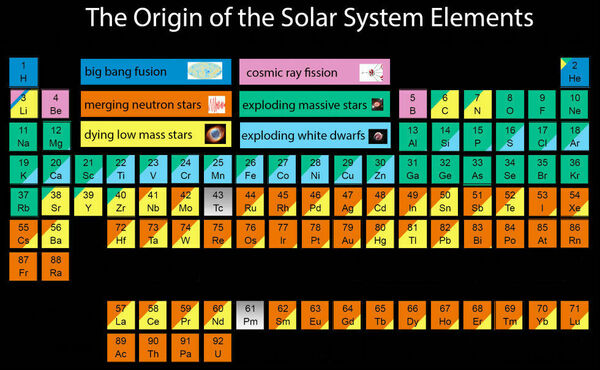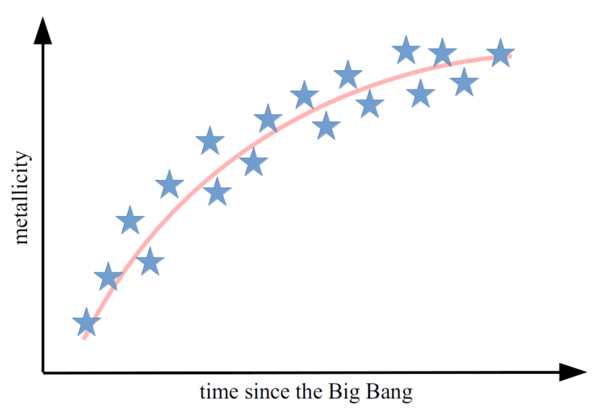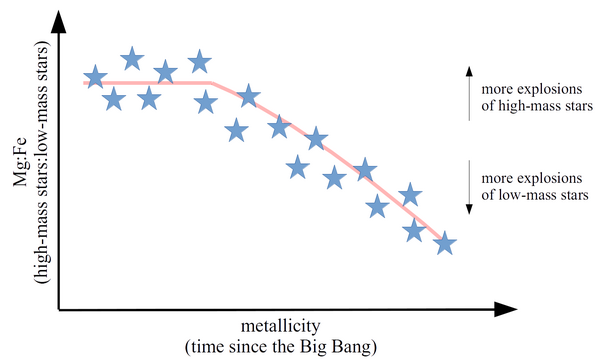Galactic Archaeology
The galactic archaeologists of Notre Dame are basically the Indiana Joneses of astrophysics. Just like Indiana Jones finds out what past civilizations were doing by analyzing their artifacts, we look into the past histories of ancient galaxies by studying the artifacts they left behind. In fact, our artifacts (stars) are 10 million times older than Indiana Jones's artifacts. Does that make us cooler than Indiana Jones? Read on to decide for yourself.
The origin of the elements
We spend lots of time measuring the composition of stars. Specifically, we pick several elements and attempt to figure out how much of that element is present inside of a star or a galaxy. Different elements encode different information about the star because different elements have different cosmic origins. In thinking about the origin of the elements, it helps to visualize the periodic table. (You didn’t think you were going to get away without seeing the periodic table, did you?)

This is a special “astronomer’s edition” of the periodic table care of Jennifer Johnson at Ohio State University. The color coding indicates the source of each element. For example, hydrogen comes exclusively from the Big Bang. Hydrogen is the simplest element, with a nucleus that consists of just one proton (and occasionally a neutron). When you encounter hydrogen, you can be reasonably sure that its proton has existed since the birth of the Universe.
Most of the elements are not primordial. They take time to appear. After the Big Bang, stars and galaxies started to appear in the Universe. All stars fuse lighter elements into heavier elements. Some of those stars explode at the ends of their lives, and this explosion releases those newly fused elements into space. Some elements are even generated in the explosion itself. (We distinguish between elements created "explosively" and elements created "hydrostatically" long before the explosion.)
Stellar explosions account for the vast majority of the mass of elements heavier than helium. Although the periodic table above shows that a lot of elements are made by merging neutron stars and dying low-mass stars, these elements are rare compared to the lighter elements.
The build-up of metals in galaxies
Over time, stars enrich the Universe with more and more "metals," which is what we call all of the elements heavier than helium. (Yes, even oxygen and neon are "metals"! This is astronomer-only nomenclature. Chemists have a very specific and very much conflicting definition of a metal!) That means the ratio of metals to hydrogen, or "metallicity," increases over time.
The older stars have lower metallicity, and the younger stars have higher metallicity. As a result, we can roughly tell the age of a star by measuring its metallicity.

We can take this logic one step further with a little discernment about what we mean by "metallicity." Specifically, which metal are we measuring? Find magnesium (Mg) and iron (Fe) on the periodic table above. You see that Mg is made almost entirely by the explosions of high-mass stars, whereas Fe is made by the explosions of low-mass stars. That means that the ratio Mg:Fe in a star is a proxy for the ratio of high-mass to low-mass stars that exploded prior to the birth of that star.


This diagram illustrates that the Mg:Fe ratio in stars tends to be lower in stars of higher metallicity. We already know that high metallicity means that the star was born more recently. Therefore, we can deduce that as time goes on, the explosions of low-mass stars become more frequent than the explosions of high-mass stars. This makes a lot of sense because low-mass stars live longer than high-mass stars. Therefore, we have to wait a while for the low-mass stars to explode and make a bunch of Fe. (Incidentally, these low-mass stars are the Type Ia supernovae that we talk about on the nucleosynthesis page.)
We make many charts like this one in our work. The elements on each axis will change, but we hope this introduction to the "elemental" side of galactic archaeology gives a good sense of how we use the elements present in stars today to learn about the stars that exploded in the past. We’re digging up evidence of the history of galaxies. Hence, Galactic Archaeology!